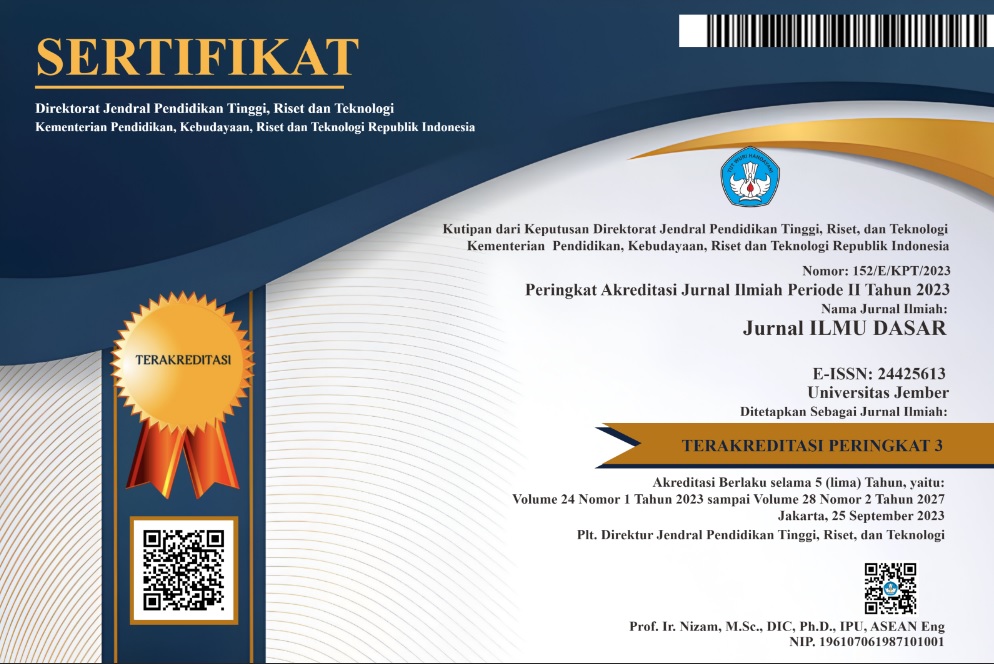The Determination of Aromatic Character of Several Local Rice Varieties using Phenotypic Analysis and Molecular DNA
DOI:
https://doi.org/10.19184/jid.v22i2.12010Abstract
The pandan scent in aromatic rice has been known as the result of 8 bp deletions and 3 Single Nucleotide Polymorphisms (SNPS) in BADH2 gene, which produce non-functional betaine aldehyde dehydrogenase (BADH) enzyme. Several DNA markers for aromatic character based on mutation in BADH2 gene have been developed. In our experiment, we analysed the presence of aromatic character in four local rice variety such as Merah Wangi, Pendok, Genjah Arum, and Mentik Wangi Susu using KOH method and DNA molecular method using three DNA markers to detect mutation that responsible for the development of aromatic character. Phenotype analysis using KOH method showed that Merah Wangi, Genjah Arum, and Mentik Wangi Susu produce pandan scents. PCR analysis using Bradbury and Badex7-5, and RM223 markers showed the presence of BADH2 mutation in Merah Wangi and Mentik Wangi Susu, whereas Pendok and Genjah Arum did not show BADH2 mutation using those used three markers. Our results indicate that among four investigated local rice, only Merah Wangi and Mentik Wangi Susu are categorized as aromatic rice whereas Pendok and Genjah Arum are non-aromatic.
Keywords: genetic analysis, aromatic rice, specific markers, genetic mutation.
Downloads
References
Ana A, Subekti S, Hamidah S & Komariah K. 2017. Organoleptic Test Patisserie Product Based on Consumer Preference. Materials Science and Engineering. 180: 1-7.
Bao G. Ashraf U, Wang C, He L, Wei X, Zheng A, Zhaowen M, & Tang X. 2018. Molecular Basis For Increased 2-acetyl-1-pyrroline Contents Under Alternate Wetting and Drying (AWD) Conditions in Fragrant Rice. Plant Physiol. Biochem. 133: 149-157
Bradbury, L. M. T., R. J. Henry, Q. Jin, R. F. Reinke, and D. L. E. Waters. 2005. A Perfect Marker for Fragrance Genotyping in Rice. Molecular Breeding. 16: 279-283.
Cing JM, Seno DSH, & Santoso TJ. 2015. Identifikasi Gen Aroma (BADH2 Termutasi) dan Analisis Aroma BC5F2Ciherang Aromatik. Current Biochemistr. 2: 42-51.
Daradjad AA, Silitonga S & Nafisah. 2015. Ketersediaan Plasma Nutfah untuk Perbaikan Varietas Padi. Sukamandi: BB Padi.
Irianto K. 2017. Biologi Molekuler. Bandung: Alfabeta.
Khush GS. 1997. Origin Dispersal Cultivation and Variation of Rice. Plant Mol. Biol. 35: 25-34.
Li M, Ashraf U, Tian H, Zhaowen M, pan S, Anjum SA, Duan M & Tang X. 2016. Manganese-induced Regulations in
Growth, Yield Formation, Quality Characters, Rice Aroma and Enzyme Involved in 2-acetyl-1-pyrroline Biosynthesis in Fragrant Rice. Plant Physiol. Biochem. 103: 167-175
Negalur RB, Halepyati AS & Rao KN. 2016. Influence of Age and Number of Seedlings on Yield and Nutrient Uptake by Machine Transplanted Rice (Oryza sativa L.). Bio-resource and Stress Management. 7: 393-397.
Sakthivel K, Rani NS, M. Pandey K, Sivaranjani AKP, Neeraja CN, Balachandran SM, Madhav M S, Viraktamath BC, Prasad GSV & Sundaram RM. 2009. Development of a Simple Functional Marker for Fragramance in Rice and Its Validation in Indian Basmati and Non-Basmati Fragramant Rice Varieties. Molecular Breeding. 24: 185-190.
Seno DSH, Nugroho S, Santoso TJ, Adrianto D, Praptiwi D, Apriana A & Mas’ud ZA. 2011. Aplikasi Berbagai Marka Aromatik Pada Varietas Padi Indonesia. Jurnal Ilmu Pertanian Indonesia. 16:149-155.
Shi W, Yang Y, Chen S & Xu, M. 2008. Discovery of A New Fragrance Allele and The Development of Functional Markers For The Breeding of Fragrant Rice Varieties. Molecular Breeding, 22: 185-192.
Sood BC & Siddiq EA. 1978. A Rapid Technique for Scent Determination in Rice. Indian J. Genes. Plant Breed. 38:268-271.
Temnykh S, Park WD, Ayers N, Cartinhour S, Hauck N, Lipovich L, Cho YG, Ishii T & Couch M. 2000. Mapping and Genome Organization of Microsatellite Sequence in Rice (Oryza sativa L.).Theory of Applied Genetics. 100: 697-712.
Widjaja R, Craske JD & Wootton M. 1996. Changes in Volatile Components of Paddy, Brown and White Fragrant Rice During Storage. J. Sci. Food Agric. 71: 218-224.
Yoshihashi T, Huong NTT & Inatomi H. 2002. Precursors of 2-acetyl-1-pyrroline, A Potent Flavor Compound of An Aromatic Rice Variety. J. Agric. Food Chem. 50: 2001-2004.








